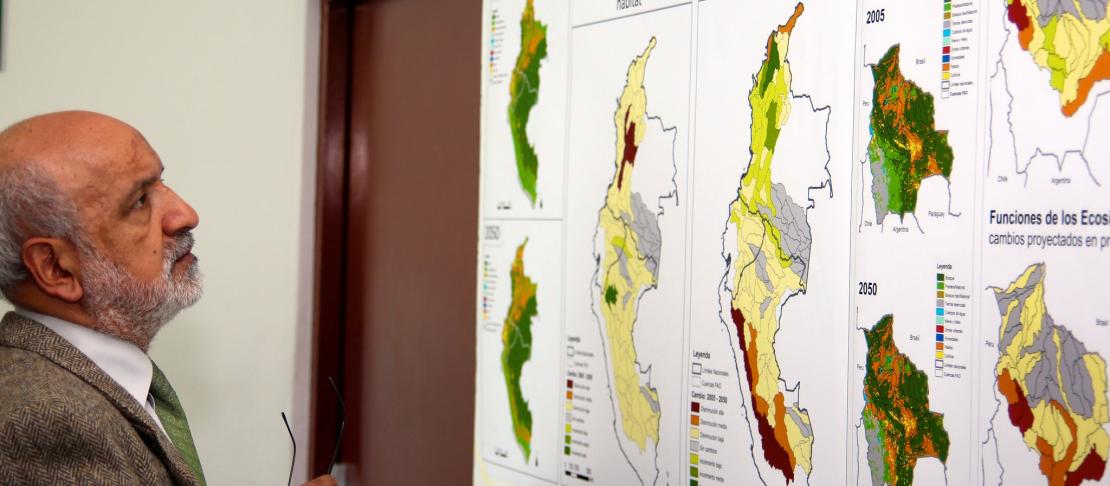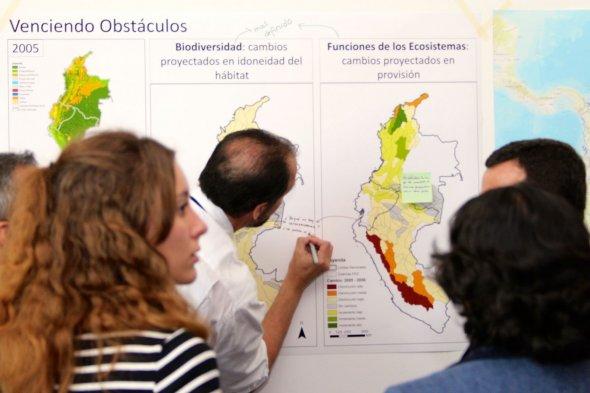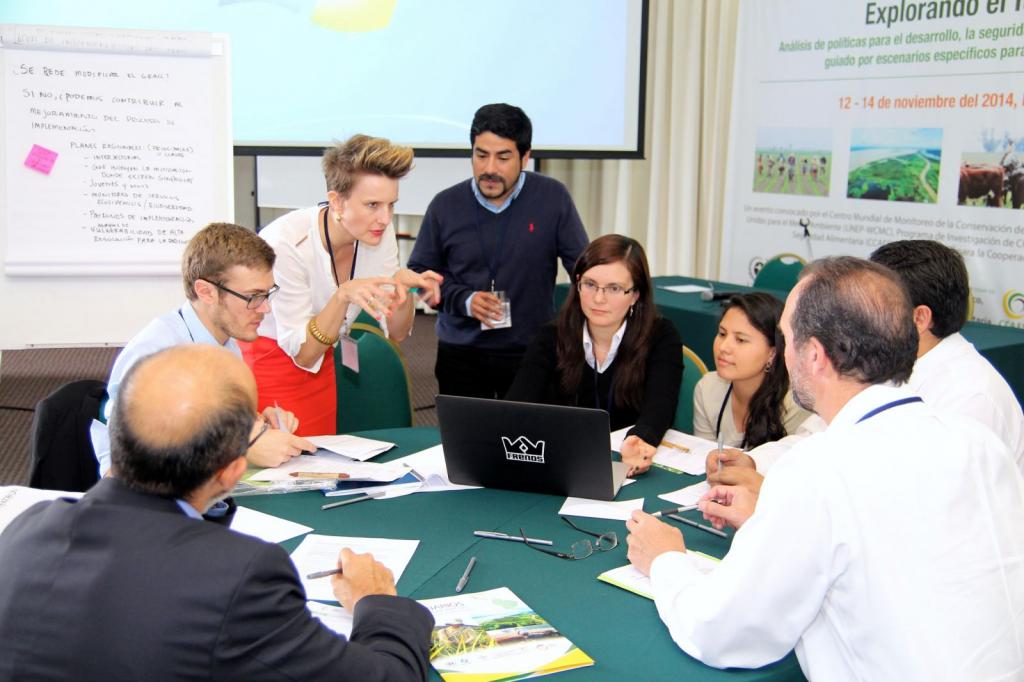Andean countries join forces to strengthen policies in the face of future scenarios

CCAFS Scenario team and partners help governments in Bolivia, Colombia, Peru and Ecuador plan under uncertainty.
In the Andean countries, policy makers looking into the future have to grapple with many changes – climate change, economic development, demographic changes, competition for land use, and numerous other pressures.
The CGIAR Research Program on Climate Change, Agriculture and Food Security (CCAFS) Future Scenarios team has joined forces with UNEP World Conservation Monitoring Centre (UNEP-WCMC) and University for International Cooperation (UCI) to help governments and their partners in Bolivia, Colombia, Peru and Ecuador plan under uncertainty.
In mid-November in Lima, Peru, key policy makers and stakeholders from other sectors from these four countries met to critically evaluate and strengthen national agricultural, environmental and climate adaptation policies from a regional perspective.

In the photo: Developing regional socio-economic and climate scenarios for the Andean countries. Photo: E. van de Grift. View more photos on CCAFS Flickr.
The CCAFS Future Scenarios and Latin America program and the University for International Cooperation (UCI) who implement the Latin American scenarios processes have worked closely with UNEP-WCMC to develop socio-economic, climate scenarios for the Andes. These scenarios were based on a first workshop with regional participants in Colombia in 2013.
The stakeholders’ regional scenarios were developed into quantitative scenarios through the agricultural economic models IMPACT and GLOBIOM to explore what the scenarios would do to regional agriculture and food security in the context of global markets and climate change. The quantified scenarios were further developed by UNEP-WCMC and the University of Kassel to create maps for land use, biodiversity and ecosystem services through the LANDSHIFT model.
One of the aims of this workshop was to review the scenarios that we have developed for this region. Also we wanted to evaluate the analysis that we have done based on these scenarios, in terms of what are the impacts of agricultural and other developments on biodiversity and ecosystem services in the region, said Arnout van Soesbergen, Programme officer at UNEP-WCMC after the workshop.
"We also looked at policies that are planned or have already been implemented and try to look at how robust the policies are in light of these future developments that we have identified in the scenarios," Van Soesbergen continued.
“The aim of that is to try and see if we can get those policies to be more robust and take into account the potential impacts of these developments on biodiversity, ecosystem services and food security, also in the light of the impacts of climate change.”
Nestor Hernandez, who is leading policy work on adaptation at the Ministry of Agriculture and Rural Development (MADR) in Colombia found the workshop to be very interesting:
In the case of Colombia, an adaptation strategy for the agricultural sector to climate phenomena is now strengthened with visions and perspectives different to the ones we initially had, and these are for sure things we had not yet thought about. This makes it a more complete proposal.
For Daguin Aguilar, from the Ministry of Agriculture, Livestock, Aquaculture and Fisheries (MAGAP) in Ecuador, the idea of comparing the scenarios with an existing policy was key.
What really caught my attention is how we addressed the current activities or the national strategies and contrasted them in a new framework to improve them and help us to reduce the risk of facing the adversities of climate change. There are some optimistic scenarios, but it was the worst case scenarios that allowed us to address the whole policy in a concrete way to determine whether we are doing it right; whether the current policies are appropriate to reach positive environmental and mitigation goals.
According to Dr. Daniel Larrea, consultant for the Foundation Friends of Nature and profesor at UMSA (Universidad Mayor de San Andrés) in Bolivia, the workshop offered an unique opportunity that brought together people representing different perspectives and sectors: “Together we could think about different issues in a collaborative way. We do not have opportunities like these very often in Bolivia.”
Larrea sees initiatives like this workshop play a very important part in addressing problems at a regional scale: “It is important to have a regional outlook on how to address problems. For me the workshop takes the lead of the current approaches of the last years. The policies that are being analyzed reflect that, still there are very different realities in each country and it is difficult to combine or find similar policies among close countries. This highlights the big difference between the policies that are being generated in climate change and food security issues.”

Workshop participants look at what the future might hold for the Andean countries. Photo: E. van de Grift.
Using scenarios successfully
The successful use of scenarios to guide policy development depends on a long process of building trust between research organizations and decision-makers, to help identify opportunities for policy development at the right time, and ensure that governments are open to engaging in a critical process of testing their plans against challenging scenarios. It also depends on having plausible, relevant and engaging scenario stories, maps and model results.
Finally, it has proven crucial to give the decision-makers the ability to deeply engage with the scenarios, letting them re-tell the stories, data and maps in a way that speaks directly to the feasibility of the policies that are being examined.
CCAFS, UCI and UNEP-WCMC are working closely with the Andean governments and their partners to make sure the improved policies and plans are finalized and accepted, and that research needs for implementation are responded to.
Learn more about the Future Scenario work:
- Helping Honduras build a more robust climate adaptation strategy for the agriculture sector
- What does the future hold for Bangladesh? Modeling scenarios for better climate policies
Blog by Elisabeth van de Grift, independent communications consultant for CCAFS Future Scenarios, and Joost Vervoort, Scenarios Officer. Photos by Elisabeth van de Grift.



